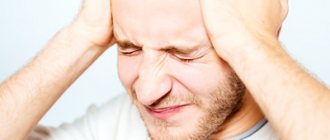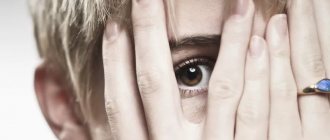If you have symptoms of thoracic neurosis, call 8(969)060-93-93 and sign up for a consultation at the Leto mental health center. Our specialists will conduct a comprehensive diagnosis, which will allow you to make the correct diagnosis and select effective treatment.
Where does chest neurosis come from?
The main cause of the disease is prolonged exposure to stress. If a person is under constant tension, his muscle tone increases. Movements become constrained. The muscles periodically spasm, which causes painful cramps. Then any sudden movement causes severe pain.
Negative symptoms persist on an ongoing basis or recur periodically. It often worsens during deep inhalation or exhalation, coughing, or when trying to perform any physical exercise. The patient's condition worsens if he has:
- Diseases of the spinal column. The problem may be associated with inflammation of the roots and joints of the spine, loss of elasticity by the intervertebral discs, etc.
- Curvature of the spine. Lordosis, kyphosis, scoliosis are diagnoses that are more often encountered by people leading a sedentary lifestyle. They slouch and make no attempt to strengthen the muscle corset of the shoulder girdle.
- History of rib fracture. The remaining deformation in the sternum area creates the prerequisites for clamps.
Among the factors complicating the course of breast neurosis:
- general hypothermia of the body;
- pneumonia;
- viral and bacterial diseases;
- pathologies of cardiovascular activity;
- oncological neoplasms in the mammary gland in women;
- diseases of the stomach and intestines.
It will not be possible to heal by eliminating only the physical component of the disease. It is imperative to stabilize the patient’s emotional background. Otherwise, a relapse of the disease will not be long in coming.
Types and types of panic attacks
Panic attacks are divided into the following types depending on the nature of their manifestation:
- Vegetative. They have pronounced symptoms - chills, trembling of the limbs, rapid heartbeat, heavy sweating, pain and dizziness in the head, etc.
- Phobic. Anxiety arises in a specific place or in a specific situation.
- Hyperventilation. This type is characterized by symptoms such as shortness of breath without physical exertion and painful sensations in the muscles.
- Conversion. The person loses his voice, and pain occurs in the left side of his chest. He may lose consciousness or be on the verge of it. At the same time, he is tormented by thoughts of death.
- Affective. The patient's mood changes, depression and inexplicable melancholy occur. Physically, you feel tired and exhausted.
- Senestopathic. “Goosebumps” are felt throughout the body, tingling and numbness occur in the limbs.
- Depersonalization-derealization. A person feels disconnected from reality and the world around him. Or it seems to him that everything around him is not happening for real.
Types of panic disorders depending on the situation:
- Spontaneous. Anxiety arises “out of the blue”, without any obvious reason.
- Situational. Panic is felt during a specific situation. This may be a premonition of a quarrel, conflict, before taking an exam, in the event of real dangers, threats to life and health.
- Conditional-situational. Symptoms appear due to the influence of any “activators” on the body. This includes taking hormonal pills, drinking alcohol, using drugs, drinking strong tea or coffee.
Types of pathology
Taking into account the location of the painful area, neurosis is classified into:
- left-handed;
- right-sided;
- bilateral.
The first option is found in medical practice more often than others. When faced with it, people often begin to think that their heart is “naughty.” Therefore, it is important not to delay visiting the doctor. Only differential diagnosis will make it possible to understand the characteristics of unpleasant symptoms and the nature of its origin.
With a right-sided disorder, it is easier to make a correct diagnosis - the doctor and the patient do not have associations with cardiovascular diseases. Therefore, the doctor can immediately assume muscle tension.
The bilateral form is the most painful. The pain has a girdling character and is excruciating. It is necessary to start treatment urgently.
The danger of panic attacks
There is nothing scary or dangerous in the phenomenon itself, since a panic attack in its essence does not harm health. If a person does not have serious chronic diseases, panic itself is safe for the body. But only from a physiological point of view. If we talk about the patient’s mental state, it leaves much to be desired. When the syndrome often manifests itself, he loses touch with reality and ceases to perceive everyday things normally. Sometimes his behavior may seem strange and even frightening to others. And the person himself feels that something inexplicable is happening to him. This worries him. If you do not address the issue of treating the root cause, then frequent attacks can subsequently lead to real mental disorders.
The condition is aggravated if a person is not understood and accepted by loved ones, does not support him, and does not help him get through a difficult stage of life. As a result, depression sets in, complete apathy and a reluctance to communicate with people or contact the outside world. Depression manifests itself along with a feeling of one’s own inferiority and inadequacy, because it seems to a person that he has serious mental problems if he cannot cope with causeless panic.
If we talk about the danger of the syndrome, then due to severe dizziness and loss of consciousness, a person is in danger of slipping, falling, and getting injured. Panic is especially dangerous for people who drive. It can cause accidents, numerous fractures and even death.
Therefore, there is no need to reassure yourself that panic in itself is not dangerous. It can provoke mental illness, cause falls and injuries. She also talks about an acute lack of oxygen in the brain. These are all “wake-up calls” that should not be ignored, because we are talking about your future.
How it manifests itself
Signs characteristic of the disorder:
- uncontrolled muscle contractions in the chest area;
- severe pain between the ribs on the right, left or both sides at once;
- discomfort in the lower back, between the shoulder blades;
- numbness of the chest, a strange sensation of “goosebumps”.
When palpated, the pain intensifies. It also becomes more pronounced when sneezing, laughing, coughing, or making sudden movements. If the patient takes painkillers, his condition will hardly improve.
Brain
Constriction of blood vessels in some parts of the brain gives two symptoms of the complex:
- feeling of weakness, faintness, dizziness (hence thoughts and fears of fainting);
- change in perception: everything around you is seen as if through a veil, through glass, it may seem somehow not real, your own body may seem changed, and you may perceive yourself as not yourself (these are symptoms of derealization and depersonalization, hence thoughts and fears about madness and loss of control ).
Why does chest neurosis need to be treated?
The disease can have various complications. The earlier therapy is started, the lower the risk of their manifestation. Among the most common consequences of untreated breast neurosis:
- Chronic pain in the ribs and back. It deprives a person of the opportunity to lead an active lifestyle, move, play sports, dance. There is a decrease in quality of life. In some cases, advanced pathology leads to loss of ability to work.
- The range of motion in the shoulder girdle is sharply reduced. A person constantly suffers due to stiffness and muscle weakness.
- Lung diseases - bronchitis, pneumonia, obstruction - become frequent. Respiratory arrest, which can lead to death, is also possible.
- Intervertebral hernias form. This is a common complication of curvature of the spinal column, osteochondrosis. Therefore, people with thoracic neurosis who are diagnosed with these diseases should be very attentive to their health.
Complications of thoracic osteochondrosis
With inadequate treatment of thoracic osteochondrosis of the spine, complications may develop in the form of the following diseases:
- protrusion;
- spinal hernia;
- kyphosis;
- stenosis;
- radiculitis;
- spinal cord compression.
Often these diseases can only be cured by surgery. To avoid this, you need to go swimming, do gymnastics regularly and strengthen your back muscles.
By visiting our clinic, you can undergo a full course of treatment for thoracic osteochondrosis under the supervision of experienced neurologists.
Examination and diagnosis
If there is discomfort in the chest, the patient is examined by a neurologist. Since the symptoms may be related to the stress experienced, a psychiatrist is involved in the work. The patient is interviewed and examined. Specialists:
- palpate the hypochondrium to determine trigger points;
- study the nature of the pain;
- exclude the presence of other diseases with similar symptoms;
- carry out CT or MRI of the chest, radiography, EEG and other instrumental examinations (as indicated).
Based on the diagnostics performed, a diagnosis is made.
Symptoms of panic attacks
The disease manifests itself differently in all people, depending on the set of symptoms. But the feeling of fear and anxiety manifests itself in this state in the same way for everyone. Here are the main signs of the syndrome:
- causeless anxiety, panic, fear;
- rapid or difficult breathing;
- rapid pulse;
- pressure disorders - can be either high or low;
- tingling sensation in the limbs, numbness in the fingers and toes;
- insomnia;
- chest pain;
- loss of consciousness.
The attacks have different durations. For some, they end in a few minutes, while for others they suffer for 1-2 hours. If we take the average time, then a person experiences an unstable mental state for about half an hour. Depending on the severity of the patient’s disease, attacks occur several times a month or every day.
Most often, symptoms worsen in situations that cause internal or physiological discomfort in the patient. This is especially true for staying in stuffy rooms, in transport, in elevators, and in crowded places.
Cost of services
| CONSULTATIONS OF SPECIALISTS | |
| Initial consultation with a psychiatrist (60 min.) | 6,000 rub. |
| Repeated consultation | 5,000 rub. |
| Consultation with a psychiatrist-narcologist (60 min.) | 5,000 rub. |
| Consultation with a psychologist | 3,500 rub. |
| Consultation with Gromova E.V. (50 minutes) | 12,000 rub. |
| PSYCHOTHERAPY | |
| Psychotherapy (session) | 7,000 rub. |
| Psychotherapy (5 sessions) | 30,000 rub. |
| Psychotherapy (10 sessions) | 60,000 rub. |
| Group psychotherapy (3-7 people) | 3,500 rub. |
| Psychotherapy session with E.V. Gromova (50 minutes) | 12,000 rub. |
This list does not contain all prices for services provided by our clinic. The full price list can be found on the “Prices” , or by calling: 8(969)060-93-93. Initial consultation is FREE!
Treatment of sternal neurosis at the Leto clinic
What procedures the therapy will include depends on the stage of the disease and the dominant symptoms. As a rule, the treatment course is aimed at:
- relieving muscle spasms;
- pain relief;
- improvement of the patient’s mental state and emotional background;
- increasing overall physical activity;
- stimulation of blood circulation.
Relieving muscle tension caused by severe nervous shock includes:
- Taking non-steroidal anti-inflammatory drugs. If they prove ineffective, a blockade is carried out. It does not eliminate the root cause of the disease, but it allows a person to be relieved of severe pain for several days.
- Steroid injections. They are used only in extreme cases, for example, if neurological symptoms are accompanied by radiculopathy.
- Physiotherapy. Good results can be obtained by ultraphonophoresis, magnetic and microwave therapy, UHF, and darsonvalization. Physiotherapy makes it possible to reduce the dose of medications used and speed up the day of recovery.
- Exercise therapy. Performing physical exercises is aimed at correcting muscle tension, improving local blood circulation, and relieving existing spasms. Particular attention is paid to stretching the back.
- Vitamin therapy. Patients are shown B vitamins and ascorbic acid. They provide support to nerve fibers and have a positive effect on the functioning of the immune system and the central nervous system.
- Massage sessions. During them, the doctor works on the chest, cervical region, and shoulder girdle. The emphasis is on relaxing cramped muscles, which ensures improvement in the client's condition.
Since the root cause of the disease is stress, observation by a psychotherapist is mandatory. The doctor helps eliminate nervous tension and overcome difficulties that arise. For this purpose, she uses individual psychotherapy sessions, cognitive-behavioral practices, trainings, relaxation sessions, etc.
We treat breast neurosis comprehensively, paying attention not only to relieving symptoms, but also to eliminating the cause and preventing complications. If you are interested in a complete recovery and no longer want to endure cramping chest pain, call - 8(969)060-93-93 . We know how to help you.
Treatment of thoracic osteochondrosis
At the early stage of osteochondrosis, for a complete cure, it is enough to follow the doctor’s recommendations - do gymnastics and swimming. But if the disease has developed more strongly, then it will have to be treated with stronger means.
The treatment course for osteochondrosis of the thoracic region is designed to stop the destruction of intervertebral discs and restore their structure. Diclofenac, ibuprofen and other non-steroidal drugs are used as anti-inflammatory drugs. Muscle tension is relieved with muscle relaxants (sirdalud or mydocalm). To stabilize the condition, chondroprotectors (glucosamine, chondroitin and others) are prescribed.
In addition to drug treatment, a rehabilitation course will be prescribed, including visits to physiotherapy rooms. Hardware physiotherapy using electromagnetic, ultrasound, and laser effects helps to successfully fight osteochondrosis. Therapeutic massage, mud therapy, taping and exercises in the pool are also recommended.
But conservative treatment does not always help. If the result is not achieved, surgical intervention may be required.









